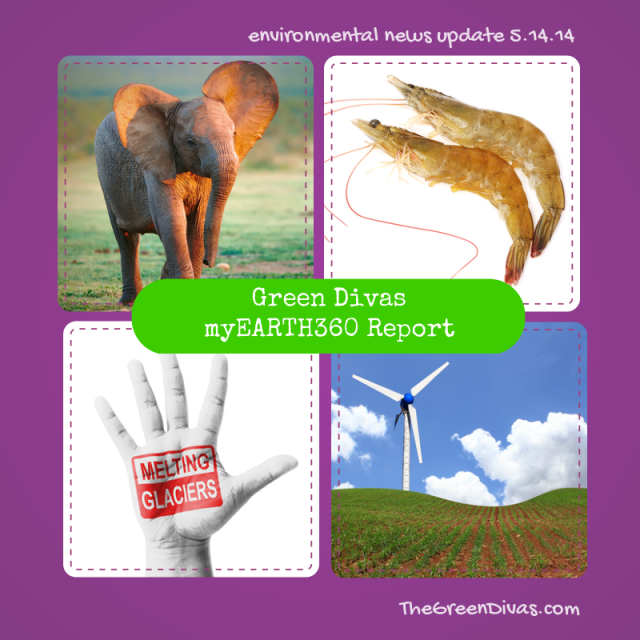Apart from the reports of the major Antarctic meltdown, which seems to be accelerating, there’s some encouraging news—shrilk. Listen to find out more in this Green Divas myEARTH360 Report, then read below for more details about these and other environmental news stories.
What’s the word in environmental news?
On May 6, a team of more than 300 experts guided by a 60-member Federal Advisory Committee produced the the National Climate Assessment—a report which was extensively reviewed by the public and experts, including federal agencies and a panel of the National Academy of Sciences.
John Holdren, Obama’s science adviser, called the report the “loudest and clearest alarm bell to date” for immediate and aggressive climate action. Uh-oh.
“Alarmist” was the word used by some in Congress and industry groups. Go figure.
And now for a dose of (ridiculous, in my opinion) denialism from Republican Senator and potential 2016 presidential candidate Marco Rubio on ABC’s This Week:
For a good laugh about Rubio and his denialism, click here.
The assessment’s findings were endorsed by oil companies such as ConocoPhillips and Chevron and (of course) environmental groups such as the Nature Conservancy.
A few of the findings included:
- Projected temperature rise of 2°F to 4°F in most areas of the United States over the next few decade. Ouch.
- A four feet sea level rise this century (a figure that may be conservative based on studies about accelerated Antarctica ice melt, which were released the week after the assessment’s release)
- Drought and flooding risks
- Food insecurity
- Increased risk of disease
Explore the full report here. It’s actually quite easy to navigate through all of the facts by region and category of impact (i.e., water supply, oceans, agriculture, human health). Click here for President Obama’s plan to prepare for the impacts.
Hope you’ll check it out!
Now for the usual breakdown in recent stories from WTF to encouraging news… plus a way to take action for the earth.
WTF News…
Melting Antarctica Glacier: “Unstoppable”
A rapidly melting section of the West Antarctic Ice Sheet appears to be in irreversible decline with nothing to stop the entire glacial basin from disappearing into the sea, according to researchers at University of California Irvine and NASA.
The new study presents multiple lines of evidence—incorporating 40 years of observations that six massive glaciers in the Amundsen Sea sector “have passed the point of no return,” according to glaciologist Eric Rignot, a University of California Irvine Earth system science professor who is also with NASA’s Jet Propulsion Laboratory. The new study has been accepted for publication in Geophysical Research Letters, a journal of the American Geophysical Union. Read more…
Watch this PBS News Hour video about the Antarctica meltdown…
Climate Change Is Turning Your Produce Into Junk Food
Climate skeptics like to point out that carbon dioxide in the atmosphere stimulates plant growth—suggesting that ever-growing fossil fuel consumption will lead to an era of bin-busting crop yields. But as I noted last week, the best science suggests that other effects of an over-heated planet—heat stress, drought, and floods—will likely overwhelm any bonus from CO2-rich air. Overall, it seems, crop yields will decline.
And here’s more bad news: In a paper published in Nature this month, a global team has found that heightened levels of atmospheric carbon make key staple crops wheat, rice, peas, and soybeans less nutritious. Read more…
Water depletion in California ‘may be increasing chance of earthquakes’
The water use that helped produce California’s agricultural bounty may be increasing the chances of earthquakes along the San Andreas fault, researchers said on Wednesday.
A new study, published in Nature on Wednesday, said groundwater depletion in California’s Central Valley – the heart of its agricultural industry – is putting additional pressures on the fault, and promoting the chances of an earthquake. Read more…
Encouraging News…
Promising solution to plastic pollution
For many people, “plastic” is a one-word analog for environmental disaster. It is made from precious petroleum, after all, and once discarded in landfills and oceans, it takes centuries to degrade.
Then came apparent salvation: “bioplastics,” durable substances made from renewable cellulose, a plant-based polysaccharide. But problems remained. For one, the current bioplastics do not fully degrade in the environment. For another, their use is now limited to packaging material or simple containers for food and drink.
Now researchers at Harvard’s Wyss Institute for Biologically Inspired Engineering have introduced a new bioplastic isolated from shrimp shells. It’s made from chitosan, a form of chitin—the second-most abundant organic material on Earth.
This environmentally safe alternative to plastic could also be used to make trash bags, packaging, and diapers. Once discarded, shrilk breaks down in just a few weeks—and even releases rich nutrients that support plant growth. Read more…
Leonardo DiCaprio gifts $1M to protect elephants
Global Renewable Energy Jobs Grow to 6.5 Million
Renewable energy employment has topped a combined 6.5 million jobs around the globe, according to a new report from the International Renewable Energy Agency (IRENA).
Released Monday morning, Renewable Energy and Jobs—Annual Review 2014 shows that jobs in the wind, solar and other clean energy sectors grew by nearly 1 million from 2012 to 2013.
China, Brazil, the U.S., India, Germany, Spain and Bangladesh are the largest employer countries for renewable energy. Read more…
Billboard sucks in pollution and turns it into purified air
Billboards often line busy roads and highways where there’s lots of traffic– and, by association, lots of air pollution. But what if those billboards could be transformed into giant air purifiers, scrubbing the air and turning polluted areas into fresh ones? That’s the idea behind a new billboard archetype created by researchers at UTEC, the University of Engineering and Technology of Peru, reports Time.
California’s Thirst Shapes Debate Over Fracking
Enemies of fracking have a new argument: drought.
Fracking a single oil well in California last year took 87 percent of the water consumed in a year by a family of four, according to the Western States Petroleum Association, an industry lobbying group. That amount — a modest one by national standards, the oil industry argues — has become an increasingly delicate topic since a drought was officially declared early this year in the state.
“There will be a statewide moratorium, whether it comes this year, next year or the year after that,” said Kathryn Phillips, the director of Sierra Club California, a leading opponent of fracking. “Even if we don’t get a moratorium, just the threat of a moratorium discourages investment.” Read more…
Take Action!
Click here to demand limits to carbon pollution, which fuels climate change and also makes us unhealthy.
Bonus!
Listen to this Green Divas Radio Show which features Greg Laden, science communicator and bioanthropologist. He talks about extreme weather patterns and how climate change is impacting us, the environment and wildlife, and why we need to pay attention.


Pingback: Animal of the Week: Baby Sea Turtles race to the ocean! | Care2 Healthy Living